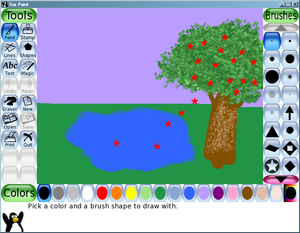Difference between revisions of "ICT student textbook/Communication with graphics"
m (→Overview) |
|||
| Line 2: | Line 2: | ||
[[File:Tuxpaint-drawing.png|thumb|A digital art creation using Tux Paint]] | [[File:Tuxpaint-drawing.png|thumb|A digital art creation using Tux Paint]] | ||
===Overview=== | ===Overview=== | ||
| − | A picture tells a thousand stories, they say! | + | A picture tells a thousand stories, they say! Have you ever wondered about how a picture can tell a story? |
| − | + | When we hear a story, when we read a story, our mind forms an image of what is being described. They make us connect to the story. Similarly, when we see a picture, our mind tries to build the story from the picture. No wonder that picture story books have been favourite reading books for children and adults. | |
| + | |||
| + | In this unit, we will learn how we can use pictures as a method of story telling. Story telling is a traditional method of transmitting information from one person to another; one generation to another. Story telling can also be used to create awareness about social issues and challenges - talk to your teacher about how Burra Katha emerged as an art form in Telangana. Drawing pictures is also not new - human beings have been using pictures to tell stories, describe things throughout our history - from cave paintings to Deccani paintings to the comic strip or to the movie poster. | ||
| + | |||
| + | Can you guess what is new about this unit? Yes, it is the use of new, digital methods to create pictures and combining them with text. This field of ICT involves the creation of visual (pictures and text) stories is called graphics and is developing fast as a method of developing communication. In the earlier unit on data processing, you saw how data is represented in multiple formats - through text, numbers, and maps, photos and pictures. | ||
| + | |||
| + | In this unit, we will focus on how we can use digital methods to create such graphic representations. | ||
| − | |||
===Objectives=== | ===Objectives=== | ||
In this unit you will be learning the following: | In this unit you will be learning the following: | ||
Revision as of 17:08, 20 November 2016
Overview
A picture tells a thousand stories, they say! Have you ever wondered about how a picture can tell a story?
When we hear a story, when we read a story, our mind forms an image of what is being described. They make us connect to the story. Similarly, when we see a picture, our mind tries to build the story from the picture. No wonder that picture story books have been favourite reading books for children and adults.
In this unit, we will learn how we can use pictures as a method of story telling. Story telling is a traditional method of transmitting information from one person to another; one generation to another. Story telling can also be used to create awareness about social issues and challenges - talk to your teacher about how Burra Katha emerged as an art form in Telangana. Drawing pictures is also not new - human beings have been using pictures to tell stories, describe things throughout our history - from cave paintings to Deccani paintings to the comic strip or to the movie poster.
Can you guess what is new about this unit? Yes, it is the use of new, digital methods to create pictures and combining them with text. This field of ICT involves the creation of visual (pictures and text) stories is called graphics and is developing fast as a method of developing communication. In the earlier unit on data processing, you saw how data is represented in multiple formats - through text, numbers, and maps, photos and pictures.
In this unit, we will focus on how we can use digital methods to create such graphic representations.
Objectives
In this unit you will be learning the following:
- Power of story telling as a method of communication
- Interpretation of picture stories
- Creating digital art
- Developing a storyline with appropriate choice of illustrations and media
- Creating a graphic communication - combining images and text
